TMA02: Leadership Analysis of FMCG Company in Singapore - Report
VerifiedAdded on 2019/10/18
|6
|1292
|214
Report
AI Summary
This report presents an analysis of a real-life situation experienced in an FMCG company in Singapore. The report details a case where a general manager, initially praised for his work ethic and contributions to profitability, exhibited a shift in behavior after promotion, leading to employee demotivation and a high attrition rate. The analysis employs two key theoretical frameworks: the behavioral approach, focusing on observable actions and their impact, and the team leadership theory, examining the qualities of effective leadership. The report highlights the manager's strengths in achieving company targets but critiques his poor treatment of employees, lack of motivation, and autocratic leadership style. The report also discusses the consequences of the manager's decisions, such as the denial of leave and the resulting resignation of an employee. It concludes by evaluating the impact of the manager's actions on stakeholders and the external environment, emphasizing the importance of employee retention and the need for a more supportive leadership approach. The analysis also includes references to relevant academic literature to support the theoretical frameworks.
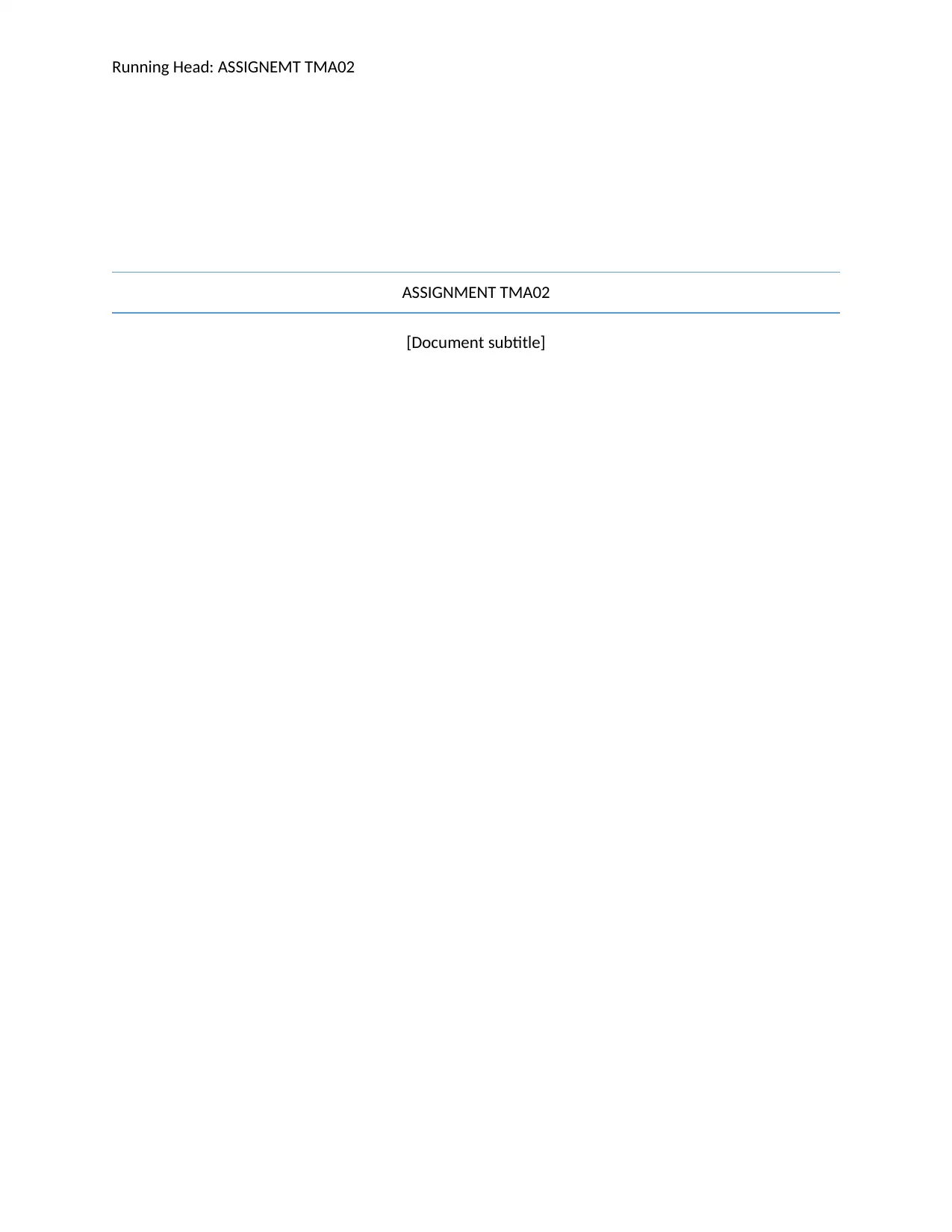
Running Head: ASSIGNEMT TMA02
ASSIGNMENT TMA02
[Document subtitle]
ASSIGNMENT TMA02
[Document subtitle]
Paraphrase This Document
Need a fresh take? Get an instant paraphrase of this document with our AI Paraphraser
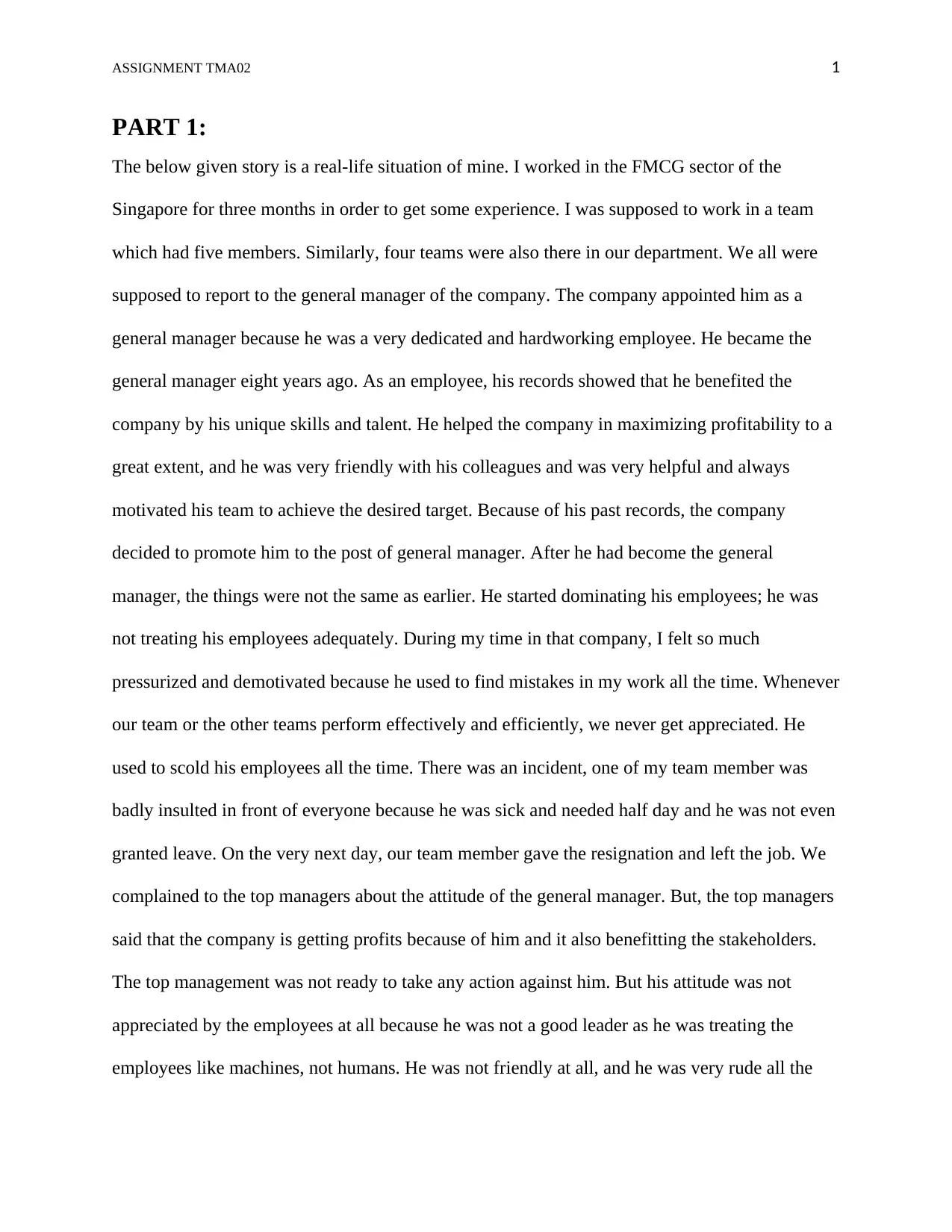
ASSIGNMENT TMA02 1
PART 1:
The below given story is a real-life situation of mine. I worked in the FMCG sector of the
Singapore for three months in order to get some experience. I was supposed to work in a team
which had five members. Similarly, four teams were also there in our department. We all were
supposed to report to the general manager of the company. The company appointed him as a
general manager because he was a very dedicated and hardworking employee. He became the
general manager eight years ago. As an employee, his records showed that he benefited the
company by his unique skills and talent. He helped the company in maximizing profitability to a
great extent, and he was very friendly with his colleagues and was very helpful and always
motivated his team to achieve the desired target. Because of his past records, the company
decided to promote him to the post of general manager. After he had become the general
manager, the things were not the same as earlier. He started dominating his employees; he was
not treating his employees adequately. During my time in that company, I felt so much
pressurized and demotivated because he used to find mistakes in my work all the time. Whenever
our team or the other teams perform effectively and efficiently, we never get appreciated. He
used to scold his employees all the time. There was an incident, one of my team member was
badly insulted in front of everyone because he was sick and needed half day and he was not even
granted leave. On the very next day, our team member gave the resignation and left the job. We
complained to the top managers about the attitude of the general manager. But, the top managers
said that the company is getting profits because of him and it also benefitting the stakeholders.
The top management was not ready to take any action against him. But his attitude was not
appreciated by the employees at all because he was not a good leader as he was treating the
employees like machines, not humans. He was not friendly at all, and he was very rude all the
PART 1:
The below given story is a real-life situation of mine. I worked in the FMCG sector of the
Singapore for three months in order to get some experience. I was supposed to work in a team
which had five members. Similarly, four teams were also there in our department. We all were
supposed to report to the general manager of the company. The company appointed him as a
general manager because he was a very dedicated and hardworking employee. He became the
general manager eight years ago. As an employee, his records showed that he benefited the
company by his unique skills and talent. He helped the company in maximizing profitability to a
great extent, and he was very friendly with his colleagues and was very helpful and always
motivated his team to achieve the desired target. Because of his past records, the company
decided to promote him to the post of general manager. After he had become the general
manager, the things were not the same as earlier. He started dominating his employees; he was
not treating his employees adequately. During my time in that company, I felt so much
pressurized and demotivated because he used to find mistakes in my work all the time. Whenever
our team or the other teams perform effectively and efficiently, we never get appreciated. He
used to scold his employees all the time. There was an incident, one of my team member was
badly insulted in front of everyone because he was sick and needed half day and he was not even
granted leave. On the very next day, our team member gave the resignation and left the job. We
complained to the top managers about the attitude of the general manager. But, the top managers
said that the company is getting profits because of him and it also benefitting the stakeholders.
The top management was not ready to take any action against him. But his attitude was not
appreciated by the employees at all because he was not a good leader as he was treating the
employees like machines, not humans. He was not friendly at all, and he was very rude all the
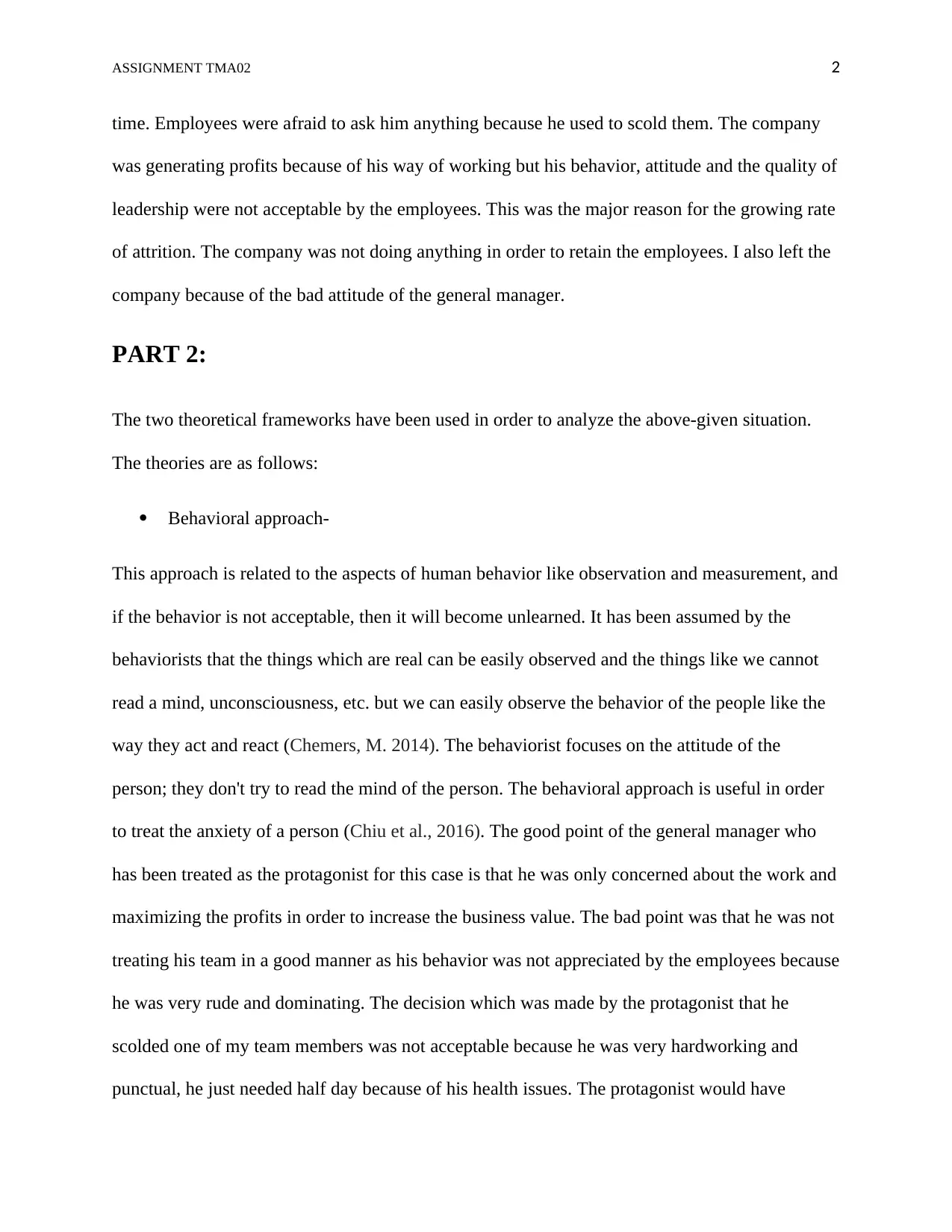
ASSIGNMENT TMA02 2
time. Employees were afraid to ask him anything because he used to scold them. The company
was generating profits because of his way of working but his behavior, attitude and the quality of
leadership were not acceptable by the employees. This was the major reason for the growing rate
of attrition. The company was not doing anything in order to retain the employees. I also left the
company because of the bad attitude of the general manager.
PART 2:
The two theoretical frameworks have been used in order to analyze the above-given situation.
The theories are as follows:
Behavioral approach-
This approach is related to the aspects of human behavior like observation and measurement, and
if the behavior is not acceptable, then it will become unlearned. It has been assumed by the
behaviorists that the things which are real can be easily observed and the things like we cannot
read a mind, unconsciousness, etc. but we can easily observe the behavior of the people like the
way they act and react (Chemers, M. 2014). The behaviorist focuses on the attitude of the
person; they don't try to read the mind of the person. The behavioral approach is useful in order
to treat the anxiety of a person (Chiu et al., 2016). The good point of the general manager who
has been treated as the protagonist for this case is that he was only concerned about the work and
maximizing the profits in order to increase the business value. The bad point was that he was not
treating his team in a good manner as his behavior was not appreciated by the employees because
he was very rude and dominating. The decision which was made by the protagonist that he
scolded one of my team members was not acceptable because he was very hardworking and
punctual, he just needed half day because of his health issues. The protagonist would have
time. Employees were afraid to ask him anything because he used to scold them. The company
was generating profits because of his way of working but his behavior, attitude and the quality of
leadership were not acceptable by the employees. This was the major reason for the growing rate
of attrition. The company was not doing anything in order to retain the employees. I also left the
company because of the bad attitude of the general manager.
PART 2:
The two theoretical frameworks have been used in order to analyze the above-given situation.
The theories are as follows:
Behavioral approach-
This approach is related to the aspects of human behavior like observation and measurement, and
if the behavior is not acceptable, then it will become unlearned. It has been assumed by the
behaviorists that the things which are real can be easily observed and the things like we cannot
read a mind, unconsciousness, etc. but we can easily observe the behavior of the people like the
way they act and react (Chemers, M. 2014). The behaviorist focuses on the attitude of the
person; they don't try to read the mind of the person. The behavioral approach is useful in order
to treat the anxiety of a person (Chiu et al., 2016). The good point of the general manager who
has been treated as the protagonist for this case is that he was only concerned about the work and
maximizing the profits in order to increase the business value. The bad point was that he was not
treating his team in a good manner as his behavior was not appreciated by the employees because
he was very rude and dominating. The decision which was made by the protagonist that he
scolded one of my team members was not acceptable because he was very hardworking and
punctual, he just needed half day because of his health issues. The protagonist would have
⊘ This is a preview!⊘
Do you want full access?
Subscribe today to unlock all pages.

Trusted by 1+ million students worldwide
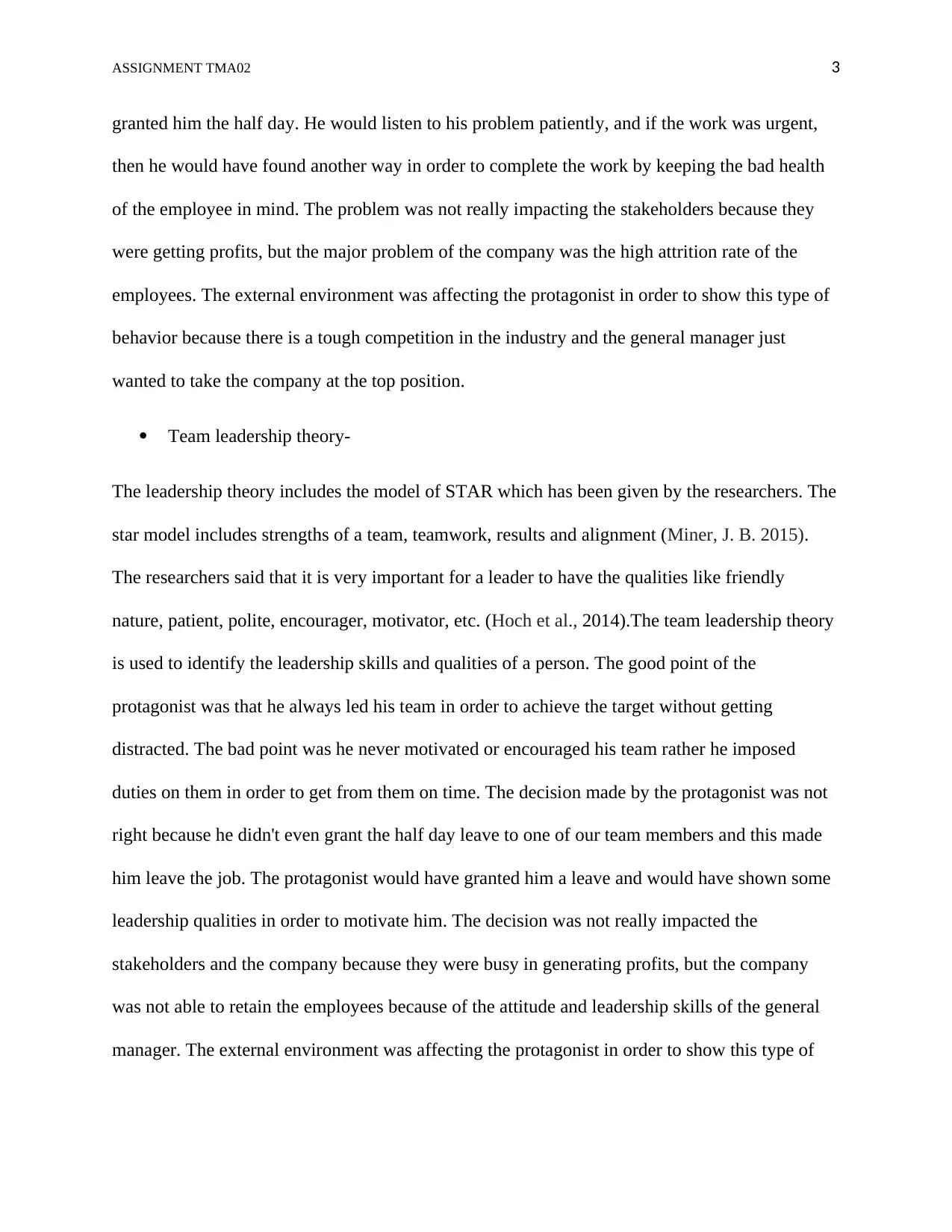
ASSIGNMENT TMA02 3
granted him the half day. He would listen to his problem patiently, and if the work was urgent,
then he would have found another way in order to complete the work by keeping the bad health
of the employee in mind. The problem was not really impacting the stakeholders because they
were getting profits, but the major problem of the company was the high attrition rate of the
employees. The external environment was affecting the protagonist in order to show this type of
behavior because there is a tough competition in the industry and the general manager just
wanted to take the company at the top position.
Team leadership theory-
The leadership theory includes the model of STAR which has been given by the researchers. The
star model includes strengths of a team, teamwork, results and alignment (Miner, J. B. 2015).
The researchers said that it is very important for a leader to have the qualities like friendly
nature, patient, polite, encourager, motivator, etc. (Hoch et al., 2014).The team leadership theory
is used to identify the leadership skills and qualities of a person. The good point of the
protagonist was that he always led his team in order to achieve the target without getting
distracted. The bad point was he never motivated or encouraged his team rather he imposed
duties on them in order to get from them on time. The decision made by the protagonist was not
right because he didn't even grant the half day leave to one of our team members and this made
him leave the job. The protagonist would have granted him a leave and would have shown some
leadership qualities in order to motivate him. The decision was not really impacted the
stakeholders and the company because they were busy in generating profits, but the company
was not able to retain the employees because of the attitude and leadership skills of the general
manager. The external environment was affecting the protagonist in order to show this type of
granted him the half day. He would listen to his problem patiently, and if the work was urgent,
then he would have found another way in order to complete the work by keeping the bad health
of the employee in mind. The problem was not really impacting the stakeholders because they
were getting profits, but the major problem of the company was the high attrition rate of the
employees. The external environment was affecting the protagonist in order to show this type of
behavior because there is a tough competition in the industry and the general manager just
wanted to take the company at the top position.
Team leadership theory-
The leadership theory includes the model of STAR which has been given by the researchers. The
star model includes strengths of a team, teamwork, results and alignment (Miner, J. B. 2015).
The researchers said that it is very important for a leader to have the qualities like friendly
nature, patient, polite, encourager, motivator, etc. (Hoch et al., 2014).The team leadership theory
is used to identify the leadership skills and qualities of a person. The good point of the
protagonist was that he always led his team in order to achieve the target without getting
distracted. The bad point was he never motivated or encouraged his team rather he imposed
duties on them in order to get from them on time. The decision made by the protagonist was not
right because he didn't even grant the half day leave to one of our team members and this made
him leave the job. The protagonist would have granted him a leave and would have shown some
leadership qualities in order to motivate him. The decision was not really impacted the
stakeholders and the company because they were busy in generating profits, but the company
was not able to retain the employees because of the attitude and leadership skills of the general
manager. The external environment was affecting the protagonist in order to show this type of
Paraphrase This Document
Need a fresh take? Get an instant paraphrase of this document with our AI Paraphraser
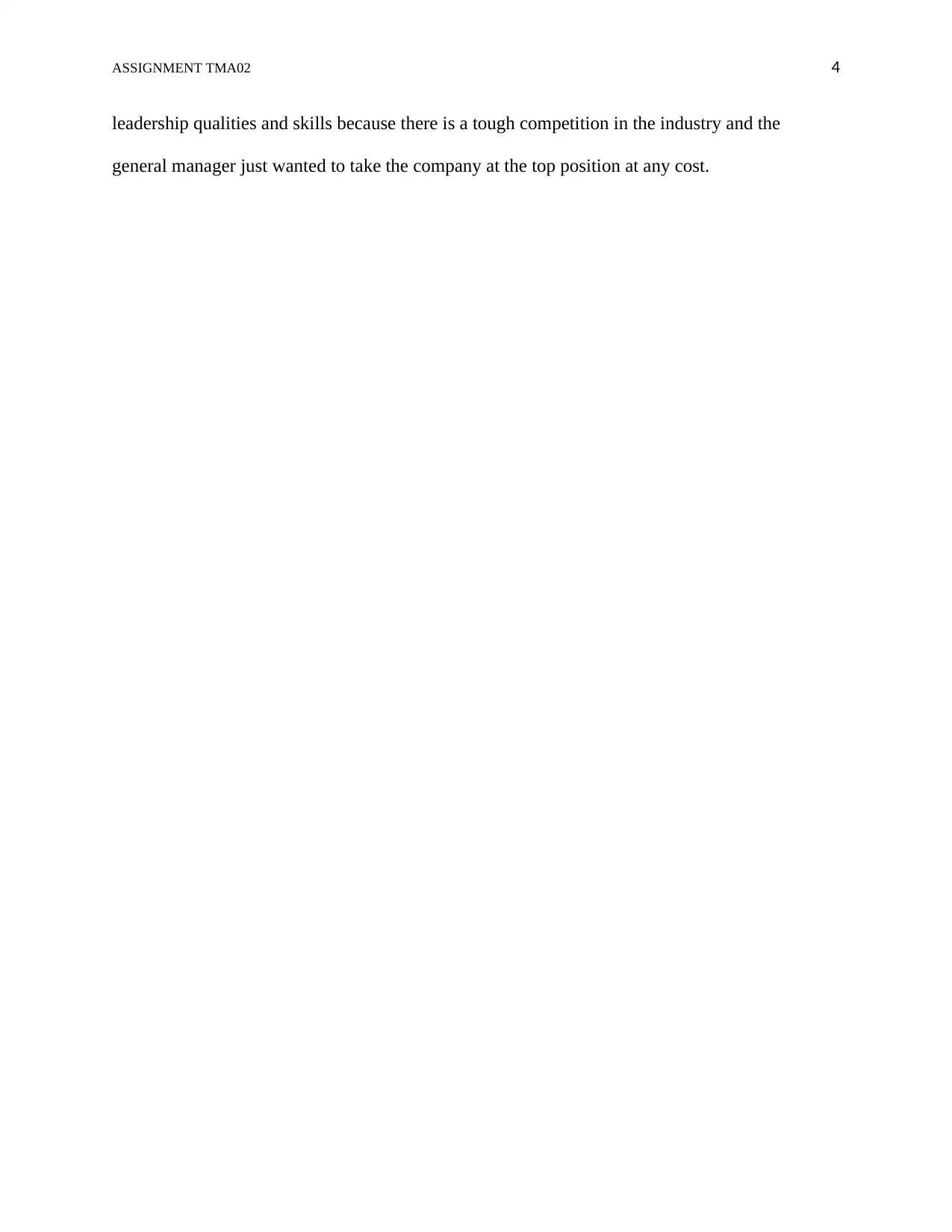
ASSIGNMENT TMA02 4
leadership qualities and skills because there is a tough competition in the industry and the
general manager just wanted to take the company at the top position at any cost.
leadership qualities and skills because there is a tough competition in the industry and the
general manager just wanted to take the company at the top position at any cost.
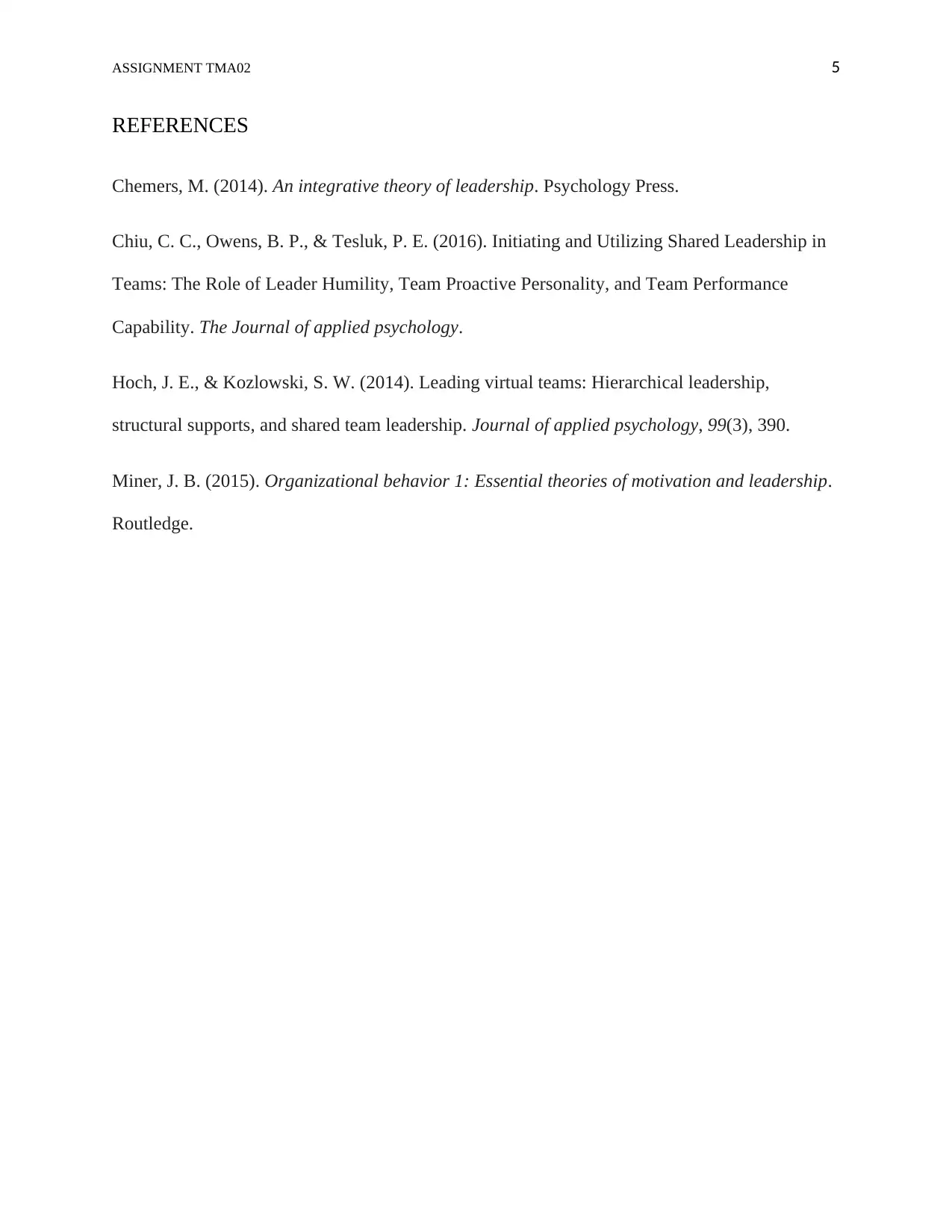
ASSIGNMENT TMA02 5
REFERENCES
Chemers, M. (2014). An integrative theory of leadership. Psychology Press.
Chiu, C. C., Owens, B. P., & Tesluk, P. E. (2016). Initiating and Utilizing Shared Leadership in
Teams: The Role of Leader Humility, Team Proactive Personality, and Team Performance
Capability. The Journal of applied psychology.
Hoch, J. E., & Kozlowski, S. W. (2014). Leading virtual teams: Hierarchical leadership,
structural supports, and shared team leadership. Journal of applied psychology, 99(3), 390.
Miner, J. B. (2015). Organizational behavior 1: Essential theories of motivation and leadership.
Routledge.
REFERENCES
Chemers, M. (2014). An integrative theory of leadership. Psychology Press.
Chiu, C. C., Owens, B. P., & Tesluk, P. E. (2016). Initiating and Utilizing Shared Leadership in
Teams: The Role of Leader Humility, Team Proactive Personality, and Team Performance
Capability. The Journal of applied psychology.
Hoch, J. E., & Kozlowski, S. W. (2014). Leading virtual teams: Hierarchical leadership,
structural supports, and shared team leadership. Journal of applied psychology, 99(3), 390.
Miner, J. B. (2015). Organizational behavior 1: Essential theories of motivation and leadership.
Routledge.
⊘ This is a preview!⊘
Do you want full access?
Subscribe today to unlock all pages.

Trusted by 1+ million students worldwide
1 out of 6
Related Documents
Your All-in-One AI-Powered Toolkit for Academic Success.
+13062052269
info@desklib.com
Available 24*7 on WhatsApp / Email
![[object Object]](/_next/static/media/star-bottom.7253800d.svg)
Unlock your academic potential
Copyright © 2020–2025 A2Z Services. All Rights Reserved. Developed and managed by ZUCOL.





